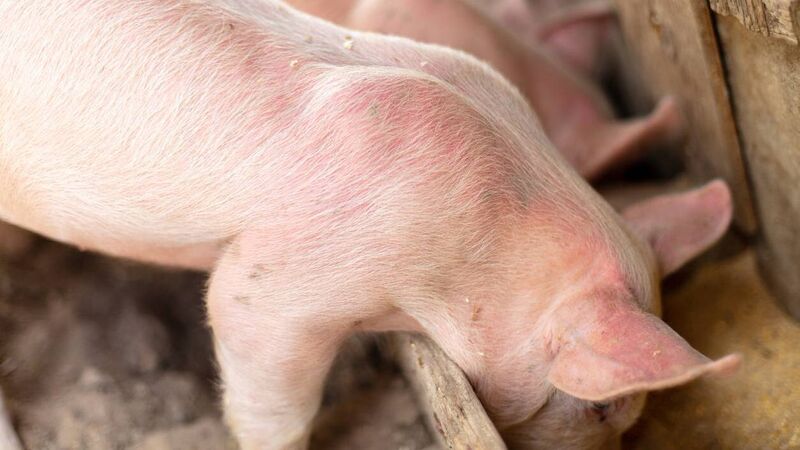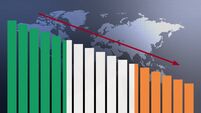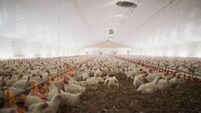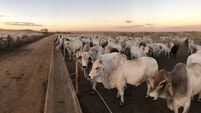Feed prices to exceed pig prices for first time

The average loss per month for a 600-sow unit is heading for over €60,000.
Teagasc has warned of eye-watering financial losses for the country’s pig farms.
The expected pig feed price (€1.46/kg) is higher than the current pig price (€1.42) for the first time ever, Teagasc Pig Development Officer Michael McKeon stated in an updated outlook report for the sector. He said the average loss per month for a 600-sow unit is heading for over €60,000.
Mr McKeon said war in Ukraine has added to pig feed cost pressures.
Beforehand, drought in South America lowered the soyabean yield from an expected 144m tonnes to what is now estimated at 133m tonnes. With Argentina’s soybean outlook also down 10% year-on-year, these reduced forecasts have increased the cost of soyabean to Irish pig producers by €50 per tonne, said Mr McKeon.
With the Ukraine situation, and the US Department of Agriculture forecasting global wheat stocks to reach a five-year low, international wheat prices which had eased at the start of 2022 are now trending back upwards.
Ukraine is the second biggest global exporter of maize and the fifth-biggest global exporter of wheat. And as Russia is the largest global wheat exporter, and international sanctions could hit these exports, the uncertainty and the risk to supply adds upward pressure on wheat and maize prices.
Mr McKeon said the Irish milling sector expects to raise pig feed prices by a further €30 in April unless there is a drop in market ingredient prices. For an average 600-sow unit, that would add €12,750 per month or €2,965 per week to costs.
In December, Teagasc had forecast an increasing Irish pig price from April due to a lower EU sow herd and higher Chinese pigmeat import demand.
However, the reduction in the Chinese sow herd has not yet led to lower slaughter volumes as much as expected, and improving Chinese import demand for EU pigmeat won’t be felt until the third quarter of 2022, not the second quarter which Teagasc forecast in December.
So the Irish pig price rise forecast in the second quarter will be at a more moderate rate than expected, and will not be sufficient to counterbalance the pig feed price rise.
Energy costs are also increasing rapidly, said Mr McKeon, with an immediate spike due to many energy providers claiming ‘force majeure’ to break contracts that originally extended into 2023.
“We now estimate that heat, power and light will double from 4.3c/kg to 8.6c/kg, and transport cost will increase from 1.6 c/kg to 2.3 c/kg, to give a combined increase of 5c/kg. For an average 600-sow unit, a 5c/kg increase equates to an increase of €6,160 per month or €73,920 annually," he said.
With the updated forecasted pig price for 2022 estimated at €1.60, and the composite pig feed price at €1.38c/kg, in 2022 the sector would require a pig price of €1.90 to cover all costs, said the Teagasc Pig Development Officer.
“But the pig price of €1.60 leaves a shortfall of 30c/kg, which equates to a €449,000 per annum loss for an average 600-sow unit.
“The average loss per month per 600-sow unit is €56,145 [February] and this will escalate to €63,967 per month in April if compound feed prices rise as forecast.”
For the year from September 2021, an average 600-sow unit will lose an estimated €527,853, which equates to €880 per sow or €31.42 per pig, warned Mr McKeon.
He said the significant increase in feed ingredient costs has resulted in a significantly higher feed credit debt burden for the individual mills and their pig producer customers.
Feed credit debt borne by the pig feed mill sector is estimated to have increased by €12.4m over the last year. If feed prices rise by €30 per tonne in April to cover higher ingredient costs, the cost of national pig feed credit will increase by a further €8.6m.
Yet another pressure on the sector is a pig backlog due to 18,143 fewer pigs going north across the border for slaughter in the late summer of 2021. This backlog has been rolled over from week to week, causing pigs to exceed their sale weight category, with a consequent price discount, lack of sales, and higher feed usage reducing cash flow income.
The Government has announced €7m of support for the pig industry, which will be distributed through a flat-rate payment of up to €20,000 per individual commercial pig farmer sending more than 200 pigs per annum to slaughter, according to Teagasc, which advised applicants to contact pigscheme@agriculture.gov.ie immediately to provide their contact details, and for further information on how to apply.
Ciaran Carroll, Head of Pigs Knowledge Transfer, said Teagasc is assisting producers to review farm costs, prepare cash flows, and access finance that is much needed to help navigate through this extremely challenging period.
“The key thing here is to talk to your advisor to develop a plan and engage with your bank early to discuss your situation. It’s also important to look after your own well-being during these times. Keep the communication channels open, be that with your family, friends, other farmers or your advisor,” said Mr Carroll.












